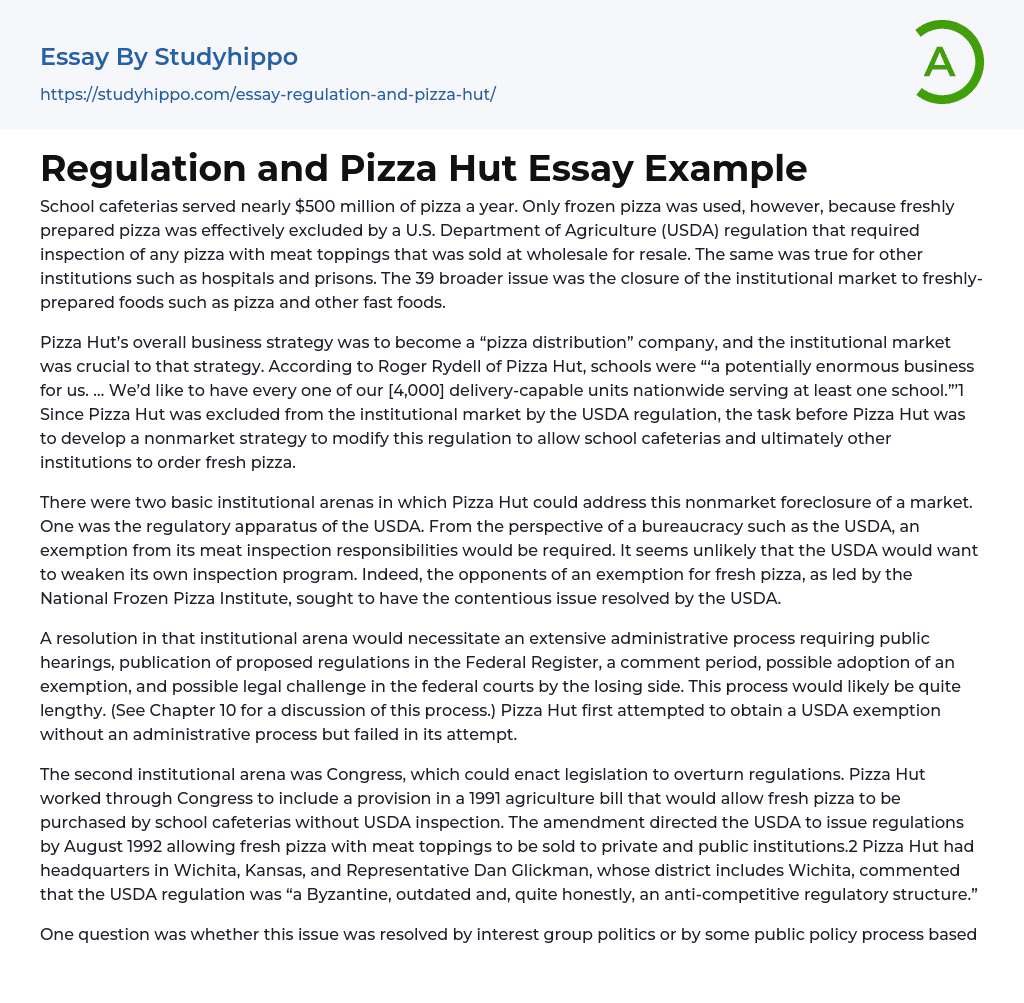Annually, school cafeterias, hospitals, and prisons served around $500 million worth of pizza. However, a USDA regulation required only frozen pizza to be used in these institutions. This meant that any meat-topped pizzas intended for resale had to be inspected. Consequently, freshly-made pizza and other fast foods were effectively prohibited from the institutional market, raising concerns about the closure of this market.
Pizza Hut had a goal of becoming a "pizza distribution" company, with the institutional market being crucial in achieving this objective. Roger Rydell, an executive at Pizza Hut, recognized the potential of schools as a business opportunity and expressed the desire to have all their delivery-capable units serving at least one school nationwide. Unfortunately, due to USDA regulations, Pizza Hut was unable to tap into the institutional market. Consequently, they ne
...eded to devise a nonmarket strategy to revise these regulations and enable school cafeterias and other institutions to order fresh pizza.
Pizza Hut had two options to deal with the nonmarket foreclosure of a market. The first option was to address it within the regulatory apparatus of the USDA. From the perspective of the USDA bureaucracy, Pizza Hut would need an exemption from its meat inspection responsibilities. It is unlikely that the USDA would be willing to weaken its own inspection program. The National Frozen Pizza Institute, as opponents of an exemption for fresh pizza, aimed to resolve this issue through the USDA.
In order to address the problem within the institutional arena, an extensive administrative procedure is required. This involves various steps such as holding public hearings, publishing proposed regulations in the Federal Register, allowing for comments,
potentially adopting an exemption, and possibly facing legal challenges in federal courts. It is anticipated that this procedure will take a considerable amount of time (For further information on this process, refer to Chapter 10). Initially, Pizza Hut attempted to obtain a USDA exemption without adhering to the administrative procedure but was not successful.
Pizza Hut collaborated with Congress to include a provision in a 1991 agriculture bill, which aimed to allow school cafeterias to buy fresh pizza without USDA inspection. The amendment instructed the USDA to create regulations by August 1992 that would enable the sale of fresh meat-topped pizza to public and private institutions. Representative Dan Glickman, who represented Wichita where Pizza Hut was located, voiced his dissatisfaction with the USDA regulation, describing it as "a Byzantine, outdated and, quite honestly, an anti-competitive regulatory structure."
Either interest group politics or a public policy process influenced the resolution of the issue at hand, taking into account costs and benefits. The opposition claimed that granting an exemption would be a health risk. Pizza Hut countered by stating that pre-cooked toppings like pepperoni had already undergone inspections during processing and slaughter. These arguments did not heavily impact the decision, except to convince Congress members that fresh pizza sold to institutions was not a health hazard. Ultimately, interest group politics played a significant role in resolving this issue, with Pizza Hut and other fast-food chains supporting the exemption while frozen pizza interests opposed it.
- Federal government essays
- Armed Forces essays
- Confederate States Of America essays
- Federal Government Of The United States essays
- Fourteenth Amendment To The United States Constitution essays
- Governance essays
- Parliament essays
- Politics essays
- Jurisdiction essays
- Bureaucracy essays
- Separation Of Powers essays
- Congress essays
- President essays
- United States Congress essays
- Non-Commissioned Officer essays
- Appeal essays
- Revenge essays
- Corporate Governance essays
- Public Service essays
- Income Tax essays
- Supply essays
- Red Cross essays
- Democracy essays
- State essays
- Liberty essays
- Absolutism essays
- Reform essays
- Republic essays
- John Marshall essays
- Bourgeoisie essays
- Developed Country essays
- Elections essays
- International Relations essays
- Left-Wing Politics essays
- Monarchy essays
- Political Corruption essays
- Political Party essays
- Political Science essays
- Sovereign State essays
- United Nations essays
- World Trade Organization essays
- Contras essays
- Dictatorship essays
- Foreign policy essays
- Monarch essays
- Corruption essays
- Foreign essays
- Democratic Party essays
- European Union essays
- President Of The United States essays




